Superior Sword Of Goujian: Jian Weapon And Legend Of Immortal With Good Advice
A. Sutherland - AncientPages.com - Goujian's sword, surprisingly rarely mentioned, belongs to the most valuable artifacts of the ancient world. Legends surround this weapon, and one of them tells that this amazing sword helped to restore a defeated state.
The sword is associated with China’s serious conflicts involving power struggles and impressive and long-lasting craftsmanship.
 Sword of Goujian. Image credit: Siyuwj - CC BY-SA 4.0
Sword of Goujian. Image credit: Siyuwj - CC BY-SA 4.0
It has survived to modern times and is still in almost perfect condition. The Chinese swords represent two types: the jian and dao. First Jian swords appeared during the Western Zhou Dynasty (1046-256 BC). It is the classic single-handed version of the Jian featured blades that were up to forty-five to eighty centimeters in length, with an average weight of about 1.5 to 2 pounds.
At first, the jians were made from bronze, later shifted to steel and wrought iron. The Jian’s blade often measured around 28 to 46 centimeters in length. By the late, Spring and Autumn Period (771 to 476 BC), the length of the Jians increased and measured around 56 centimeters
The sword of Goujian can still cut a pile of 20 sheets of paper, which is a weapon sharpness test.
Outstanding Casting Of The Sword
The casting of the sword is exceptional. It owes its durability above all to an almost air-tight scabbard, in which this weapon is stored, and to its excellent chemical composition. The sword is made of an alloy of copper, tin, and small amounts of nickel, sulfur, and aluminum.
The proportions vary depending on the place: the copper covering the stem of the weapon gives it hardness; the tin on the edges makes it sharper, while the beautiful floral designs contain sulfur, resistant to the passage of time.
The object in question is the oldest known Jian weapon, a double-edged, one-handed sword, intended only for noble families. In Chinese culture and art, it was often compared with a stick, a saber, and a spear.
Combat using this type of weapon was based primarily on cuts and thrusts, but it was possible to use it in many different ways.
In modern times, the Chinese Jian swords are used for sporting and entertainment purposes.
Origin Of The Sword Was Long Debated
The sword of Goujian is 55.7 centimeters (21.9 in) long with a 4.6-centimeter-wide blade at its base. Its handle is 8.4-centimeters (3.3 in) - long handle.
Each side of the blade is decorated with turquoise and blue crystals. On the blade near the handle, eight seal characters have been translated to:
“The Sword belongs to Goujian, the King of Yue State.”
The sword weighs 875 grams (30.9 oz). The decoration of the sword includes blue crystals and turquoise and a repeating dark rhombi (parallelogram) pattern on both sides of the blade.
Goujian's sword was discovered in October 1965 while working on creating a reservoir on the Zhang River in Jiangling District in Jingzhou Prefecture. According to experts, the sword belonged to the alleged Chinese leader Goujian (Gou Jian), the King of the Yue State in the Spring and Autumn Period. He ruled the State of Yue in the years 496 - 465 BC and was continuously involved in the wars with the Wu kingdom. Relations between the two states already deteriorated significantly during the reign of his father, Yunchang.
Finally, Goujian was defeated, but he did not give up.
Goujian’s Sword And Legend Of Immortal
In 494 BC, Goujian was captured by the state of Wu and served as a servant to its king for three years before being released. Returning home, Goujian resumed his reign, but it was no easy task.
Surrounded by very experienced politicians as advisers, the king determined to take his revenge. At first, however, he needed powerful weapons.
Hearing of Goujian’s plan, an older man named Ouyezi started trying to make swords but unfortunately failed. One night, he dreamed of an immortal who suggested going to Qinxi Mountain where gems and magic water were available. With this unusual inspiration, Ouyezi cast five rare swords: Zhanlu, Chunjun, Shengxie, Juque, and Yuchang.
The Sword of Goujian, according to experts and available descriptions, is similar to the one called Chunjun. After ten years of reforms, a significant strengthening of his kingdom, and taking advantage of the external and internal conflicts devastating Wu kingdom, Goujian again joined the war; he still wanted to take revenge, and this time, he was victorious.
Legends say that the famous sword accompanied the ruler at the time of triumph.
Written by – A. Sutherland - AncientPages.com Senior Staff Writer
Updated on June 30, 2021
Copyright © AncientPages.com All rights reserved. This material may not be published, broadcast, rewritten or redistributed in whole or part without the express written permission of AncientPages.com
Expand for referencesReferences:
Pegg R. Tony Yang T. Chinese Swords: An Ancient Tradition and Mode
Olivia Milburn O. The Glory of Yue
More From Ancient Pages
-
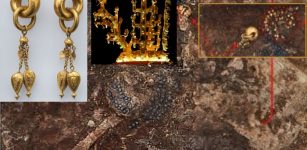 South Korea’s Silla-Era Tombs Reveal More Priceless Jewelry
Archaeology | Sep 9, 2020
South Korea’s Silla-Era Tombs Reveal More Priceless Jewelry
Archaeology | Sep 9, 2020 -
 Did Pharaoh Shishak Plunder King Solomon’s Temple?
Biblical Mysteries | Jan 15, 2020
Did Pharaoh Shishak Plunder King Solomon’s Temple?
Biblical Mysteries | Jan 15, 2020 -
 Lost Biblical City, Ancient Treasure And Atlantis – Biblical And Archaeological Perspective
Ancient Mysteries | Apr 27, 2018
Lost Biblical City, Ancient Treasure And Atlantis – Biblical And Archaeological Perspective
Ancient Mysteries | Apr 27, 2018 -
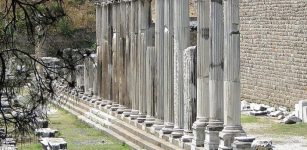 Greek God Asclepius And Ancient Healing Center ‘Asclepion Of Pergamum’
Civilizations | Nov 29, 2014
Greek God Asclepius And Ancient Healing Center ‘Asclepion Of Pergamum’
Civilizations | Nov 29, 2014 -
 Forbidden Knowledge: Secret Ancient Gates Of The Shining Ones – The Beginning – Part 1
Ancient Mysteries | Jul 12, 2019
Forbidden Knowledge: Secret Ancient Gates Of The Shining Ones – The Beginning – Part 1
Ancient Mysteries | Jul 12, 2019 -
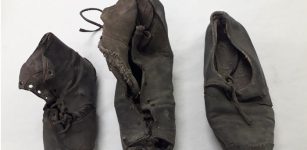 Mystery Of The Hidden Shoes Discovered In Ancient European Houses – What Is Behind This Bizarre Tradition?
Featured Stories | Oct 2, 2021
Mystery Of The Hidden Shoes Discovered In Ancient European Houses – What Is Behind This Bizarre Tradition?
Featured Stories | Oct 2, 2021 -
 Jedek: Previously Unidentified Language Found By Swedish Linguists In in Southeast Asia
Linguistic Discoveries | Feb 9, 2018
Jedek: Previously Unidentified Language Found By Swedish Linguists In in Southeast Asia
Linguistic Discoveries | Feb 9, 2018 -
 Unknown Ancient History Of Antarctica And It’s Lost Civilization – Secrets Beneath The Ice
Ancient Mysteries | Sep 7, 2015
Unknown Ancient History Of Antarctica And It’s Lost Civilization – Secrets Beneath The Ice
Ancient Mysteries | Sep 7, 2015 -
 Two Well-Preserved Shipwrecks Found By Swedish Maritime Divers In Baltic Sea
Archaeology | Jan 30, 2018
Two Well-Preserved Shipwrecks Found By Swedish Maritime Divers In Baltic Sea
Archaeology | Jan 30, 2018 -
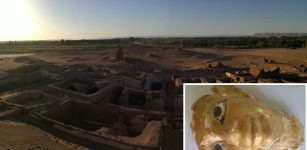 Five Ancient Roman Tombs With Different Architectural Style Discovered In Egypt
Archaeology | Aug 26, 2017
Five Ancient Roman Tombs With Different Architectural Style Discovered In Egypt
Archaeology | Aug 26, 2017 -
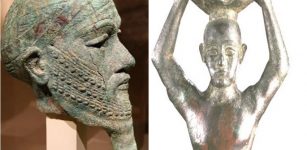 King Ur-Nammu – King Of Ur, King Of Sumer And Akkad – The One Who Built The Temple Of God Enlil
Ancient History Facts | Aug 30, 2015
King Ur-Nammu – King Of Ur, King Of Sumer And Akkad – The One Who Built The Temple Of God Enlil
Ancient History Facts | Aug 30, 2015 -
 Oldest Human Remains Unearthed In Vietnam
Archaeology | Nov 15, 2023
Oldest Human Remains Unearthed In Vietnam
Archaeology | Nov 15, 2023 -
 Rare Byzantine Gold Coin Discovered In Norway – Was It Brought By Harald Hardrada From Constantinople
Archaeology | Dec 12, 2023
Rare Byzantine Gold Coin Discovered In Norway – Was It Brought By Harald Hardrada From Constantinople
Archaeology | Dec 12, 2023 -
 Denisovans Were First To Adapt To High Altitude And Harsh Conditions Of Tibetan Plateau
Archaeology | May 2, 2019
Denisovans Were First To Adapt To High Altitude And Harsh Conditions Of Tibetan Plateau
Archaeology | May 2, 2019 -
 Mystery Of The Ancient Bear Bones In The Aleutian Islands, Alaska
Archaeology | Oct 5, 2023
Mystery Of The Ancient Bear Bones In The Aleutian Islands, Alaska
Archaeology | Oct 5, 2023 -
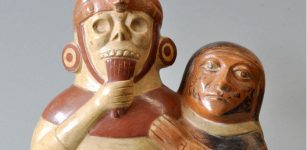 South American Musical Instruments Reflect Population Relationships – Archaeological Records Reveal
Archaeology | Sep 20, 2021
South American Musical Instruments Reflect Population Relationships – Archaeological Records Reveal
Archaeology | Sep 20, 2021 -
 Did The Babylonian Fish-God Oannes Visit Tiahuanacu?
Ancient Mysteries | May 12, 2014
Did The Babylonian Fish-God Oannes Visit Tiahuanacu?
Ancient Mysteries | May 12, 2014 -
 Unique Medieval Horsemen Sculptures Made By Unknown Creators In India – Puzzling Discovery In The Himalayas
Archaeology | Oct 23, 2017
Unique Medieval Horsemen Sculptures Made By Unknown Creators In India – Puzzling Discovery In The Himalayas
Archaeology | Oct 23, 2017 -
 Huge 36-Million-Year-Old Skull Of Fearsome Marine Monster Discovered In Peru
Fossils | Mar 21, 2022
Huge 36-Million-Year-Old Skull Of Fearsome Marine Monster Discovered In Peru
Fossils | Mar 21, 2022 -
 Mounds In Louisiana, North America Offer Insight Into Middle Archaic Lifestyles
Archaeology | Dec 2, 2022
Mounds In Louisiana, North America Offer Insight Into Middle Archaic Lifestyles
Archaeology | Dec 2, 2022

